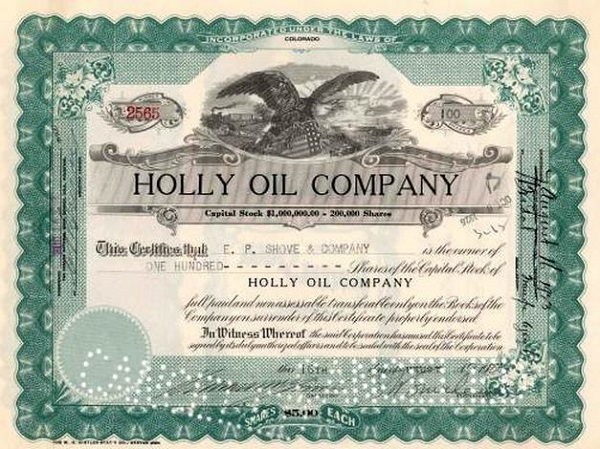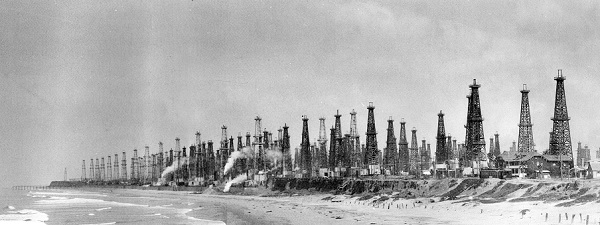
Although oil seeps along California’s coastline had drawn petroleum companies there as early as the 1890s, it would be decades before the rich pools were revealed. Stretching from Huntington Beach to north of Santa Barbara, several fields contained billions of barrels of oil.The Holly Oil Company was organized under the laws of Colorado, on June 14, 1921, to acquire and develop oil lands located in California’s Huntington Beach oilfield. It was a sugar company’s idea.
Huntington Beach’s growth began following a May 24,1920, discovery of the largest California oil deposit known at the time.

The Huntington Beach oilfield, circa 1926. Although still a productive oilfiled, less drilling by the early 1950s led to dismantling of derricks within the city and along the coast. Photo courtesy Orange County Archives.
Wells sprang up overnight and in less than a month the town grew from 1,500 to 5,000 people. A real estate boom brought thousands to the nearby community of Sunset Beach.
The city’s derricks were disappearing by the time the the last successful well was drilled in 1953 – the same year the city’s first surf shop, Gordie’s Surf Boards, opened.
Oil for Sugar Beets
At Huntington Beach, the Holly Sugar Company’s sugar beet refinery near the intersection of Gothard and Garfield streets had been there since 1911.
In order to devote the 14.7-acre property entirely to drilling for oil, the company disassembled its sugar beet refinery and shipped to Torrington, Wyoming, where it was rebuilt and operating by 1926.
Stockholders of Holly Sugar Company, founded in 1905 in Holly, Colorado, were given first preference to purchase shares of the new Holly Oil Company stock at $2 a share. It seems to have been a sweet deal.
The former sugar beet refinery property soon had 16 producing wells (including a 1,150 barrel a day well in 1922). Five railroad sidings were constructed to handle the 24-hour-a day-oil operations.
By 1923, daily oil production from Holly Oil wells reached 6,300 barrels. Records show the company was still actively drilling in the Huntington Beach oilfield in 1926, drilling the Conrad No. 1 well and the 1927 Huntington No. 2 well.
The California Department of Oil, Gas and Geothermal Resources’ last record of Holly Oil Company drilling was in 1940 when the company drilled and plugged the Meherin No. 1 well in San Luis Obispo County.
With its finely detailed vignette of an eagle with shield, Holly Oil Company stock certificates can be found online valued at about $50.
America’s offshore exploration industry began in the 1890s with drilling piers along the West Coast. Learn more California petroleum history in Discovering the Los Angeles Oilfield.
___________________________________________________________________________________
The stories of exploration and production companies joining petroleum booms (and avoiding busts) can be found updated in Is my Old Oil Stock worth Anything? The American Oil & Gas Historical Society preserves U.S. petroleum history. Please support this AOGHS.ORG energy education website. For membership information, contact bawells@aoghs.org. © 2018 Bruce A. Wells.

